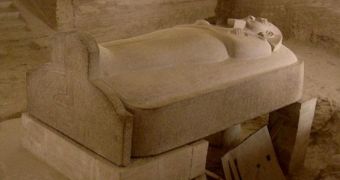The biggest Egyptian sarcophagus was discovered in a tomb located in the Valley of Kings, announced the Society for the Study of Egyptian Antiquities and the Royal Ontario Museum's Friends of Ancient Egypt at a Toronto symposium hold last week.
Dated to over three millenniums ago, the sarcophagus is believed to have belonged to Merneptah, a warrior Egyptian pharaoh supposed to have led big defensive battles with the Libyans and a group of “Sea Peoples,” as well as offensive expeditions against the “Israel” people in the Levant.
The giant royal funeral receptacle consists of a set of four stone sarcophagi placed one within the other, measuring a 13-foot (4-meter) length and 7-foot (2.3-meter) width. The boxes were made of red granite and although now their original aspect is difficult to be determined, archaeologists estimate they must have been fairly colorful at the beginning.
The site analysis has revealed the tomb's doors have passed through a process of destruction and re-building, which suggested the sarcophagi were most probably built outside the tomb and subsequently brought in with the Pharaoh's mummy already inside.
A mismatching between the size of the sarcophagus and that of the entrance must have caused the destruction of the doors and their ulterior rebuilding.
“I always like to wonder about the conversation that might have taken place between the tomb builders and the people from the quarry,” said Edwin Brock, a research associate at the Royal Ontario Museum in Toronto and director of the project, as cited by Live Science.
“This study has shown a lot of interesting little human aspects about ancient Egypt [that] perhaps makes them look less godlike.”
Merneptah's tomb was first discovered in the 1980s and the scarcity of the remains caused it going through a large reconstruction process ever since.
The quadruple composition of the sarcophagus and its unusual size have been object to deep amazement and large research. A clue to the reason why it was built this way was offered by the boxes' decoration, archaeologists say.
The illustrations, consisting of two books sequenced in 12 divisions, suggest that “they're trying to enclose the [king's] body with these magical shells that have power of resurrection,” Brock explained.

 14 DAY TRIAL //
14 DAY TRIAL //